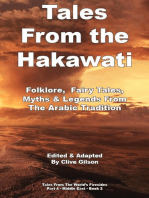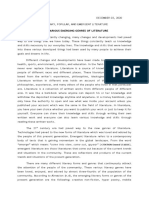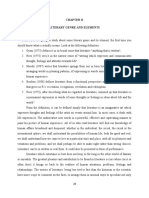Professional Documents
Culture Documents
Louise Erdrich William Faulkner Stream of Consciousness: As I Lay Dying
Louise Erdrich William Faulkner Stream of Consciousness: As I Lay Dying
Uploaded by
UTSAV PATHAKOriginal Description:
Original Title
Copyright
Available Formats
Share this document
Did you find this document useful?
Is this content inappropriate?
Report this DocumentCopyright:
Available Formats
Louise Erdrich William Faulkner Stream of Consciousness: As I Lay Dying
Louise Erdrich William Faulkner Stream of Consciousness: As I Lay Dying
Uploaded by
UTSAV PATHAKCopyright:
Available Formats
A writer may choose to let several narrators tell the story from different points of view.
Then it is up
to the reader to decide which narrator seems most reliable for each part of the story. It may refer to
the style of the writer in which he/she expresses the paragraph written. See for instance the works
of Louise Erdrich. William Faulkner's As I Lay Dying is a prime example of the use of multiple
narrators. Faulkner employs stream of consciousness to narrate the story from various perspectives.
In Indigenous American communities, narratives and storytelling are often told by a number of elders
in the community. In this way, the stories are never static because they are shaped by the
relationship between narrator and audience. Thus, each individual story may have countless
variations. Narrators often incorporate minor changes in the story in order to tailor the story to
different audiences.[17]
The use of multiple narratives in a story is not simply a stylistic choice, but rather an interpretive one
that offers insight into the development of a larger social identity and the impact that has on the
overarching narrative, as explained by Lee Haring. [18] Haring analyzes the use of framing in oral
narratives, and how the usage of multiple perspectives provides the audience with a greater
historical and cultural background of the narrative. She also argues that narratives (particularly
myths and folktales) that implement multiple narrators deserves to be categorized as its own
narrative genre, rather than simply a narrative device that is used solely to explain phenomena from
different points of view.
Haring provides an example from the Arabic folktales of A Thousand and One Nights to illustrate
how framing was used to loosely connect each story to the next, where each story was enclosed
within the larger narrative. Additionally, Haring draws comparisons between Thousand and One
Nights and the oral storytelling observed in parts of rural Ireland, islands of the Southwest Indian
Ocean, and African cultures such as Madagascar.
"I'll tell you what I'll do," said the smith. "I'll fix your sword for you tomorrow, if you tell me a story
while I'm doing it." The speaker was an Irish storyteller in 1935, framing one story in another
(O'Sullivan 75, 264). The moment recalls the Thousand and One Nights , where the story of "The
Envier and the Envied" is enclosed in the larger story told by the Second Kalandar (Burton 1 : 113-
39), and many stories are enclosed in others."[18]
You might also like
- The Short Story An IntroductionDocument302 pagesThe Short Story An IntroductionBalu Bold95% (22)
- ENG KotRA - Shonen - Single PageDocument81 pagesENG KotRA - Shonen - Single PageAyleronNo ratings yet
- Development of Short StoryDocument9 pagesDevelopment of Short StoryFarooq Ali Khan0% (1)
- The Conscript: A Novel of Libya’s Anticolonial WarFrom EverandThe Conscript: A Novel of Libya’s Anticolonial WarRating: 4 out of 5 stars4/5 (1)
- Unit About The Short Story: StructureDocument12 pagesUnit About The Short Story: StructureMEG MENTORS IGNOU MA ENGLISHNo ratings yet
- Meetings 3 - Topic Literary GenresDocument19 pagesMeetings 3 - Topic Literary GenresMalik ZaynNo ratings yet
- The Wicked StepmotherDocument24 pagesThe Wicked StepmotherLizwa FulaniNo ratings yet
- Legend - WikipediaDocument6 pagesLegend - WikipediamangueiralternativoNo ratings yet
- Short Stories QuestionDocument17 pagesShort Stories QuestionarshadjappaNo ratings yet
- Philppine Literature Study GuideDocument8 pagesPhilppine Literature Study GuidePrecious Rachel TuanoNo ratings yet
- Short StoryDocument16 pagesShort StorySotoza Jr Josue JucarNo ratings yet
- Short Story Definition, Development and EvoluionDocument13 pagesShort Story Definition, Development and EvoluionSyed NaqeeNo ratings yet
- Kanda RiDocument5 pagesKanda RikariNo ratings yet
- Legend - WikipediaDocument5 pagesLegend - Wikipedianfx87946No ratings yet
- Short StoryDocument11 pagesShort StoryLeo LonardelliNo ratings yet
- The History and Origin of Short StoryDocument1 pageThe History and Origin of Short StoryUdit BajpaiNo ratings yet
- Unit 2Document10 pagesUnit 2Sachin KulshresthaNo ratings yet
- Filipino FolkloreDocument11 pagesFilipino FolkloreMaicy GallinoNo ratings yet
- Di Biase-Dyson, Narratives by Ancient Egyptians and of Ancient Egypt. A State of The Art PDFDocument25 pagesDi Biase-Dyson, Narratives by Ancient Egyptians and of Ancient Egypt. A State of The Art PDFAnonymous 5ghkjNxNo ratings yet
- The Hybridity of Narrative Form and Language in 'Haroun and The Sea of Stories'Document6 pagesThe Hybridity of Narrative Form and Language in 'Haroun and The Sea of Stories'Madalina Ardelean100% (1)
- CHDocument40 pagesCHRahul Kumar SenNo ratings yet
- Anthropology and Humanism - 2008 - Narayan - Ethnography and Fiction Where Is The BorderDocument14 pagesAnthropology and Humanism - 2008 - Narayan - Ethnography and Fiction Where Is The Bordermigbrown80No ratings yet
- World LiteratureDocument32 pagesWorld LiteratureJay VaronaNo ratings yet
- MythologyDocument9 pagesMythologyrensebastianNo ratings yet
- Rocky Mountain Modern Language Association Rocky Mountain Review of Language and LiteratureDocument17 pagesRocky Mountain Modern Language Association Rocky Mountain Review of Language and LiteratureBrena MouraNo ratings yet
- Tales From The HakawatiFrom EverandTales From The HakawatiClive L GilsonNo ratings yet
- Non-Verbal Semiotic Modes and MediaDocument16 pagesNon-Verbal Semiotic Modes and MediaAnonymous gp78PX1WcfNo ratings yet
- Stylistic Analysis of A Short StoryDocument10 pagesStylistic Analysis of A Short StoryHumu RajpootNo ratings yet
- Happy Prince PDFDocument6 pagesHappy Prince PDFAnonymous INdzUrY100% (2)
- Today: o o o o o oDocument5 pagesToday: o o o o o oMohamad BauloNo ratings yet
- Introduction To Short StoryDocument4 pagesIntroduction To Short StoryGodwin GaakuNo ratings yet
- The Who Came in From The Cold:: Le Carre's A Structuralist ReadingDocument17 pagesThe Who Came in From The Cold:: Le Carre's A Structuralist Readingsophia0207No ratings yet
- Popular LiteratureDocument8 pagesPopular LiteratureClarisse Madayag100% (1)
- NARRATIONDocument3 pagesNARRATIONcemepa3673No ratings yet
- 21st CL Q1W7 Module 7Document28 pages21st CL Q1W7 Module 7Adell Anne OngNo ratings yet
- SVFC - Phil Lit - Module 1 - Lecture IntroDocument6 pagesSVFC - Phil Lit - Module 1 - Lecture IntroAviannaNo ratings yet
- Afua HirschDocument4 pagesAfua HirschConner ChenNo ratings yet
- Short Story: Citation NeededDocument6 pagesShort Story: Citation NeededDPWH-SFDEO PDSNo ratings yet
- Research Paper On Salman RushdieDocument4 pagesResearch Paper On Salman Rushdieafeaxlaaa100% (1)
- Short Story NoteDocument9 pagesShort Story Noted.dNo ratings yet
- Dialect Characters Analysis in Twain's Huckleberry FinnDocument15 pagesDialect Characters Analysis in Twain's Huckleberry Finnmossaaljunidi765No ratings yet
- 4.4. Virginia Woolf-KewDocument3 pages4.4. Virginia Woolf-KewLore JimenezNo ratings yet
- Emergence of Novelfactors Leading To The Composition of Joseph AndrewsDocument3 pagesEmergence of Novelfactors Leading To The Composition of Joseph Andrewsfarzanahamid143No ratings yet
- ReportDocument30 pagesReportavnishNo ratings yet
- Reaction PaperDocument10 pagesReaction PaperMary May BalagbisNo ratings yet
- Andrade AdichiesGenealogiesNational 2011Document12 pagesAndrade AdichiesGenealogiesNational 2011Khyati ParasharNo ratings yet
- Presentation 1Document6 pagesPresentation 1Jericho AgcaoiliNo ratings yet
- Philippine Literature Part IDocument69 pagesPhilippine Literature Part IPhilip LaraNo ratings yet
- Intro To Literary StudiesDocument6 pagesIntro To Literary StudiesductcleaningcleanairNo ratings yet
- Quarter 2 Week 1 Day 3 Narrative WritingDocument17 pagesQuarter 2 Week 1 Day 3 Narrative WritingWilbeth PanganibanNo ratings yet
- 707 Short Story1 Theoretical BackgroundsDocument12 pages707 Short Story1 Theoretical BackgroundsAmiria TizieNo ratings yet
- A9ab3dc7 Ffa3 4c58 Be18 E656ed5b7c0c UntitledDocument3 pagesA9ab3dc7 Ffa3 4c58 Be18 E656ed5b7c0c Untitledsaud KhanNo ratings yet
- Legends of the Middle Ages - Narrated with Special Reference to Literature and ArtFrom EverandLegends of the Middle Ages - Narrated with Special Reference to Literature and ArtRating: 4 out of 5 stars4/5 (1)
- Wuthering Heights Emily BronteDocument26 pagesWuthering Heights Emily BrontehashemdoaaNo ratings yet
- Introduction of LiteratureDocument4 pagesIntroduction of LiteratureLukman SyahbanaNo ratings yet
- Short Story DetailedDocument30 pagesShort Story DetailedChuii MuiiNo ratings yet
- Phil Lit Chapter 1-5Document25 pagesPhil Lit Chapter 1-5Nezuko CutieeeNo ratings yet
- ArcghctvbuivbnikiloDocument5 pagesArcghctvbuivbnikiloZena ChiiNo ratings yet
- Task 3 Intercultural CompetenceDocument11 pagesTask 3 Intercultural CompetenceClaudia patricia de la OssaNo ratings yet
- Tema 9 Literatura Norteamericana UNEDDocument28 pagesTema 9 Literatura Norteamericana UNEDJose Antonio Rodriguez AlmagroNo ratings yet
- Literary Genre and Elements I.LiteratureDocument36 pagesLiterary Genre and Elements I.LiteratureKHAIRUN NISANo ratings yet
- Q1. Write A Travel Report For Armand Denis's Journey To CongoDocument2 pagesQ1. Write A Travel Report For Armand Denis's Journey To CongoUTSAV PATHAKNo ratings yet
- Kathmandu University School of Engineering Department of Civil and Geomatics EngineeringDocument3 pagesKathmandu University School of Engineering Department of Civil and Geomatics EngineeringUTSAV PATHAKNo ratings yet
- First-Person Third-Person Narrative Gérard GenetteDocument1 pageFirst-Person Third-Person Narrative Gérard GenetteUTSAV PATHAKNo ratings yet
- An Essay On Criticism An Essay On Man An Essay Concerning Human Understanding An Essay On The Principle of PopulationDocument1 pageAn Essay On Criticism An Essay On Man An Essay Concerning Human Understanding An Essay On The Principle of PopulationUTSAV PATHAKNo ratings yet
- and Poetic Drama Like: Fiction-Writing Mode Literary Criticism Poetry Epic Poems Shakespeare Poems Novels 18th CenturyDocument1 pageand Poetic Drama Like: Fiction-Writing Mode Literary Criticism Poetry Epic Poems Shakespeare Poems Novels 18th CenturyUTSAV PATHAKNo ratings yet
- Montaigne: Commonplacing Plutarch Jacques AmyotDocument1 pageMontaigne: Commonplacing Plutarch Jacques AmyotUTSAV PATHAKNo ratings yet
- Tim Southee Is The Player of The MatchDocument1 pageTim Southee Is The Player of The MatchUTSAV PATHAKNo ratings yet
- Michel de MontaigneDocument1 pageMichel de MontaigneUTSAV PATHAKNo ratings yet
- Losing Captain Virat KohliDocument1 pageLosing Captain Virat KohliUTSAV PATHAKNo ratings yet
- Winning Captain Kane WilliamsonDocument1 pageWinning Captain Kane WilliamsonUTSAV PATHAKNo ratings yet
- Winning Captain Kane WilliamsonDocument1 pageWinning Captain Kane WilliamsonUTSAV PATHAKNo ratings yet
- Prospects of Mountaineering and Trekking Tourism in NepalDocument13 pagesProspects of Mountaineering and Trekking Tourism in NepalUTSAV PATHAKNo ratings yet
- Research ProposalDocument7 pagesResearch ProposalUTSAV PATHAKNo ratings yet
- Research Proposal FinalDocument6 pagesResearch Proposal FinalUTSAV PATHAKNo ratings yet
- Learning Kit CNF Q1 Week 1Document10 pagesLearning Kit CNF Q1 Week 1Loreza BallesterosNo ratings yet
- (Download pdf) Chat Gpt Bible 10 Books In 1 Everything You Need To Know About Ai And Its Applications To Improve Your Life Boost Productivity Earn Money Advance Your Career And Develop New Skills Codi Byte full chapter pdf docxDocument70 pages(Download pdf) Chat Gpt Bible 10 Books In 1 Everything You Need To Know About Ai And Its Applications To Improve Your Life Boost Productivity Earn Money Advance Your Career And Develop New Skills Codi Byte full chapter pdf docxsekotoartai100% (12)
- Al Alto+clef+&aqs Chrome 0 69i59l2j69i57j69i60l2 399Document1 pageAl Alto+clef+&aqs Chrome 0 69i59l2j69i57j69i60l2 399Amor ProfanoNo ratings yet
- T3 - Week 7-9 - Learner Guide - Art AppreciationDocument3 pagesT3 - Week 7-9 - Learner Guide - Art AppreciationANGELA LUCERO GARCIANo ratings yet
- Don't Be Shy! Show Them How Fabulous You Are! This Is A Great Spot For A Glowing Testimonial.Document1 pageDon't Be Shy! Show Them How Fabulous You Are! This Is A Great Spot For A Glowing Testimonial.Heyson PazNo ratings yet
- Optoma ES520 User ManualDocument55 pagesOptoma ES520 User Manualatif385No ratings yet
- Swan LakeDocument2 pagesSwan LakeAshish JaiswalNo ratings yet
- Assumptions and Nature of ArtDocument20 pagesAssumptions and Nature of ArtROLAND ROBLESNo ratings yet
- Hoa - 1 QuestionsDocument16 pagesHoa - 1 QuestionsNiña Jayne GurangoNo ratings yet
- Doing Without: FREE Waldorf Baby Doll Pattern and Instructions!Document21 pagesDoing Without: FREE Waldorf Baby Doll Pattern and Instructions!Josefina DabaNo ratings yet
- Class 6-8 Half Yearly Exam Date Sheet 2022Document1 pageClass 6-8 Half Yearly Exam Date Sheet 2022Bhavya TyagiNo ratings yet
- Lirik Lagu Justin Bieber Baby Feat LudacrisDocument2 pagesLirik Lagu Justin Bieber Baby Feat LudacrisAdi RiyadiNo ratings yet
- ARTICLE REVIEW On ChristianDocument5 pagesARTICLE REVIEW On ChristianAgegnehuNo ratings yet
- Linear3 Vs Linear5 enDocument1 pageLinear3 Vs Linear5 enasdqwerNo ratings yet
- Essay On Online LearningDocument3 pagesEssay On Online Learningafibyoeleadrti100% (2)
- Surrealism and Abstract RealismDocument4 pagesSurrealism and Abstract RealismJae JaraNo ratings yet
- Scriptura Beneventana - Example of European Calligraphic Script in The Middle AgesDocument34 pagesScriptura Beneventana - Example of European Calligraphic Script in The Middle AgesAnte VukicNo ratings yet
- History of Hip Hop MusicDocument1 pageHistory of Hip Hop Musicjavierheredia777No ratings yet
- Recorder Making: Report To The Winston Churchill Memorial Trust of AustraliaDocument12 pagesRecorder Making: Report To The Winston Churchill Memorial Trust of Australiajuandale100% (2)
- Demi Lovato - Skyscraper - CifraDocument2 pagesDemi Lovato - Skyscraper - CifraNELSINDOMUSICNo ratings yet
- Summer Fun Guide (2023)Document32 pagesSummer Fun Guide (2023)The Livingston County NewsNo ratings yet
- National Artists Visual ArtsDocument66 pagesNational Artists Visual Artsshey mahilumNo ratings yet
- Iraq Embassy - AbujaDocument7 pagesIraq Embassy - AbujaWale AbereojeNo ratings yet
- Art Blakey DiscographyDocument8 pagesArt Blakey DiscographybooksfNo ratings yet
- My Favorite Color by Aaron Becker Press ReleaseDocument2 pagesMy Favorite Color by Aaron Becker Press ReleaseCandlewick PressNo ratings yet
- Review of Fundamentals of Critical Writing and Review TextbookDocument8 pagesReview of Fundamentals of Critical Writing and Review TextbookAlaribe KelechiNo ratings yet
- Synyster GatesDocument2 pagesSynyster GatesMuhammad MukhsinNo ratings yet
- Full Chapter Tragedy and Postcolonial Literature Ato Quayson PDFDocument53 pagesFull Chapter Tragedy and Postcolonial Literature Ato Quayson PDFkaren.hamamoto422100% (3)
- Art Education Final ExamDocument3 pagesArt Education Final ExamsheenaNo ratings yet







































































































